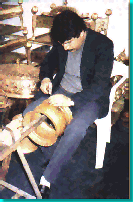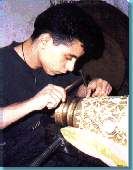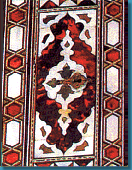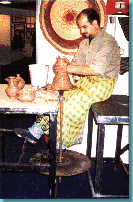The Seminar took the following recommendations among others:
| 1. Creation of Awareness and Educating the Society |
| Our aim is to call attention, to arouse interest and to encourage the need to cherish handicrafts, to do all we can to preserve and to foster them, for they have occupied such a major role in our civilization. They bear an exquisite art form, they occupy a sublime role, and represent a precious and rare aesthetic value. |
| 2. Tradition and Modernity |
| To find one's roots is a national and a cultural necessity. In order to protect our cultural identity, in this era of international opening up of countries to technology and urbanism on all levels and in all fields, we should not be mere imitators of Western art. The differentiating features between the various civilizations in all their aspects tend to disappear in front of this incursion. The time element and the striving toward rapid world development has made us lose some traditional values for some imported ones that are threatening our heritage. The seriousness of the situation should lead us to the re-evaluation of our distinctive features and cultural identity in all the fields, to reject all that which is foreign to our culture and all that clashes with our religion and traditions. We must work as hard as possible to protect our traditional heritage transmitted from one generation to the next in order and its development, to rediscover the traditions and customs that differentiate us from other cultures and countries. |
| 3. Government and Patronage |
| Our duty is to help the artists safeguard the craftsmanship and expertise inherited by the craftsmen in order to put forth beautiful works of art. The help of the government should be comprehensive, support the artists in their creativity, in their artistic expertise and in the transmission of their knowledge from one generation to the next in order to realise this artistic continuity between past and present. A national training center should be established in Damascus for decorative arts. The center would also patronize and help the artists in this field by providing them the necessary techniques, the required raw material, and offering them opportunities for the exhibition of their works. |
| 3. Design & Islamic Ornaments: Revival and Reuse of the Traditional Design |
| Call for encouraging and reviving the continuity of the contribution of Arabesque in Crafts through ages in order to preserve its traditional forms, in a way of providing a rich reference for the resources to be used by contemporary craftspeople.
To define the technical fields that reflect the spirit of Islamic heritage and attempt to benefit from Islamic art, and at the same time, to emphasize the necessity for setting up programs and taking measures which aim to ensure creativity, research and organising a system of crafts qualification |
| 5. Education and Training |
To reactivate the role of Arabesque artisans who are the proper tool for the contemporary original product through:
|
| 6. Marketing Future Prospects |
|
| 7. Research and Documentation |
| Call for encouraging the research in the field of Arabesque crafts, and for its documenting and indexing through the establishment of a data bank about the information and designs available in Islamic Arabesque and then having it available for the services of an international training center for arabesque as an important reference for craftspeople, researchers and trainees in this field. |
| 8. Directory of Arabesque Artisans of the Muslim world |
| This list has not been compiled yet. It should include hundreds of names in all fields of creativity in Arabesque in a way that will serve researchers, architects, craftspeople and artists as well as enabling them to learn about the different aspects of these arts in various countries. |
| 9. Inter-Regional Program for Craft Development |
| Appreciating the efforts of IRCICA, UNESCO and UNIDO in the field of Crafts development, the seminar called the three bodies to cooperate among themselves along with the concerned authorities in OIC Countries for Launching an Inter-Regional Program for the development of decorative Islamic Crafts. |




Participants also expressed their appreciation for the warm hospitality, the comfortable and well-organized work conditions provided by the organizers, namely, the Syrian Ministry of Culture, headed by H.E. Dr. Najah al-Attar, Minister of Culture, The Research Center for Islamic History, Art and Culture (IRCICA), Istanbul, and the fruitful cooperation of UNESCO and MASHAREQ International Establishment.